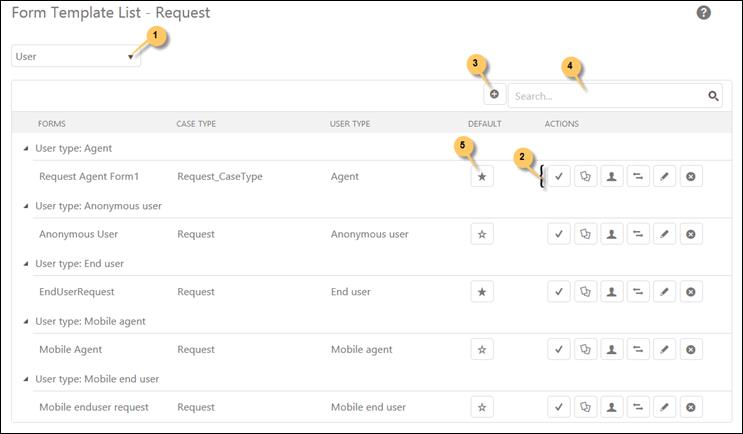 ) in Entity Editor, the Form Template List
for the selected entity will be displayed:
) in Entity Editor, the Form Template List
for the selected entity will be displayed: Using Form Editor you can create and manage entity forms, e g forms containing properties for different ticket types. Entity forms are displayed under Add + button in Dashboard screen and when End User Submit a Ticket. Each entity form is unique and has different fields.
You can create, edit, clone, activate or deactivate, change ticket type, and delete entity forms and you can also define the scope of a form and make the form as a default. The form is only displayed to the users covered under the defined scope.
This option is available for each entity in the list.
When you click on Edit
Entity Form button ( ) in Entity Editor, the Form Template List
for the selected entity will be displayed:
) in Entity Editor, the Form Template List
for the selected entity will be displayed:

Form Template List
This form lists already added entity form templates, active forms followed by inactive ones. At the top of the form, there is dropdown (1) available to filter the list of the forms based on its scope. Scopes are: User, Group, Organization and System wide.
Each item in this list has Actions buttons (2, 5) associated with it:
 Activate: Used to activate or deactivate
the form template.
Activate: Used to activate or deactivate
the form template.
 Clone: Used to clone the selected form
template to create a new.
Clone: Used to clone the selected form
template to create a new.
 Permissions: Used to set or edit the
permissions of the form.
Permissions: Used to set or edit the
permissions of the form.
 Change Ticket Type:
Used to change the Ticket
Type of a form. This option is only available for the entities
which base type is Base
Request. When you click this action, Ticket Type field is replaced
with a dropdown list containing various active ticket types defined for the
entity.
Change Ticket Type:
Used to change the Ticket
Type of a form. This option is only available for the entities
which base type is Base
Request. When you click this action, Ticket Type field is replaced
with a dropdown list containing various active ticket types defined for the
entity.
 Edit: Used to edit the entity form
template. Edit opens Form Template Builder, the same form as
when you add a new form template.
Edit: Used to edit the entity form
template. Edit opens Form Template Builder, the same form as
when you add a new form template.
 Delete: Used to delete entity form
template.
Delete: Used to delete entity form
template.
 Default: Used to set the form
template as default entity form. Only one template can be set as default for
each User Type (Scope). Default form will be opened when user clicks the Add + button in
dashboard (Agents) or Submit a request menu in Self Service Portal
(End Users).
If forms are created in different scopes (1), there will exist default forms under each
scope. The default form will then be selected from scopes in
following order: 1. System
wide, 2. Organization, 3. Group, 4. User.
Default: Used to set the form
template as default entity form. Only one template can be set as default for
each User Type (Scope). Default form will be opened when user clicks the Add + button in
dashboard (Agents) or Submit a request menu in Self Service Portal
(End Users).
If forms are created in different scopes (1), there will exist default forms under each
scope. The default form will then be selected from scopes in
following order: 1. System
wide, 2. Organization, 3. Group, 4. User.
Search (4) functionality is useful when you have to deal with the large amount of data. As soon as you type in the search box, the data in the list will be updated based on entered keyword.
To add a new entity Form Template, click Add new record button just beside the search box (3). This action will open the Form Template Builder.
Note: The form builder functionality is license controlled, meaning that there could be a limitation in the number of forms the system can hold. If it is not possible to add forms this could be the reason and you need to upgrade NSP to other product version, see Nilex Products.